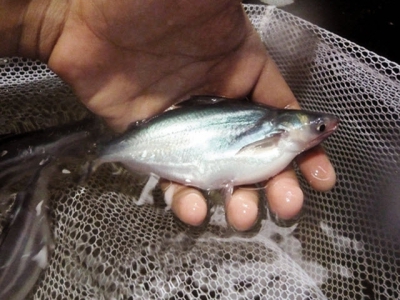Pangasius farming - An overview

In Part One of this four-part series, The Fish Site explores the ins and outs of pangasius farming.
Pangasius aquaculture first began in the 1940's in Vietnam and continues today along the Mekong River Delta region. Photo: Shutterstock
Long popular with the Vietnamese, it is exported to over 100 nations with principle markets in Europe, the United States and Russia. Demand for the fish is high and expected to go up, while a range of aquaculture production techniques has allowed the number of fish being produced to rise sharply.
Pangasius
Although Pangasius is mostly found in freshwater, it can live in salt concentrations of around 0.7 percent - 1 percent and alum water (PH >5) which can be tolerated at temperatures of around 30°C.
With a streamlined body, dark grey coloured back, silver belly, wide mouth and long twin beard, Pangasius has more red blood cells than other fish, an additional respiratory organ and can breathe through bubbles and skin. This means it is able to tolerate environments with little dissolved oxygen.
Its growth rate is rapid and it can live in the wild for as long as 20 years. After around 2 months during breeding, it reaches about 10-12cm long and 14-15 grams in weight.
By the age of 10, it can reach around 25kg in farming ponds, and those weighing between 800 - 1,100 grams after 6 - 8 months (not including the breeding stage) are best for harvesting.
Why pangasius?
Pangasius has a range of qualities that make it a suitable candidate for aquaculture. Its geographic range for potential culture covers areas with adequate water resources such as the global tropics.
More recently, aquaculture operations have moved to Ben Tre, Tien Giang and Vinh Long Provinces near the Mekong River's mouth where ecological conditions are favourable thanks to natural tidal movements twice a day and some large and small islands far from residential areas.
Production methods such as hormone induced spawning have allowed Pangasius aquaculture to develop rapidly and for the fish to become a globally important product. Areas such as hybridisation, genetic selection for positive production traits and increased introduction to suitable culture environments also appear to offer potential for further improvement, opportunities and development.
The fish's relatively low cost, mild flavour and delicate texture have allowed consumption to rise across the world. In the meantime, large-scale production in Vietnam and additional production by countries such as China have led to the marketing of Pangasius filets at low prices. This has significantly contributed to the fish's rapid growth and acceptance on world markets.

Pangasius tends to be exported as skinless, boneless fillets, and its flesh colour will vary from white, cream, yellow or rose depending on feed, processing, culture conditions and the environment. Photo: Shutterstock
The culture of pangasius
Primarily reared in ponds and cages, Pangasius is usually stocked at high densities (around 60 -80 fish per m2) and grown for around 6- 8 months before reaching its harvest weight of around 1kg.
Males and females grow at similar rates, with the reproduction temperature between 26 and 28°C.
The spawning period is between February and October, with the age of sexual maturity known to be 3 - 3.5 years.
Pangasius are also highly fecund; females can produce up to 80,000 eggs/kg and can be spawned several times. Pond production can lead to yields of around 250 - 300mt/ha, more than 4 times that of other aquaculture species.
Cage production occurs in impoundments, lakes or rivers, and stocking densities tend to be around 100 - 150 fish/m3 and yields from around 100 - 120kg/m3. Floating cages also help maintain continuous water exchange and allow higher fish densities and productivity.
Pangasius tends to be exported as skinless, boneless fillets, and its flesh colour will vary from white, cream, yellow or rose depending on feed, processing, culture conditions and the environment.
Floating feeds and good water quality lead to white fillets, while yellow flesh is said to come from non-commercial or natural food sources.
Pangasius by-products are also used in various applications such as fishmeal, bio-diesel and cosmetics, and because the flesh has a medium firm fine-grained texture and mild flavour, it's also suitable for a range of value-added products.
The culture of Pangasius has faced some issues concerning environmental impact. For example, the collection of fry from the Mekong River reduced natural fisheries and impacted on other species, but this problem is being addressed through home spawning techniques as well as governmental restrictions on collecting fry and harvesting wild stocks.
Today, farms are obliged to provide information on any possible environmental impact before farming operations can begin.
Pangasius exhibits a range of potential advantages in terms of reproductive capacity, resistance to low dissolved oxygen and production yields. Further development of aquaculture standards will help define how the Pangasius aquaculture industry can improve further and secure a sustainable future.
As the demand for safe and sustainable seafood continues to go up, it's likely that the culture and consumption of Pangasius could become more mainstream.
Related news
 Effects of Bamboo Charcoal Added Feed on Reduction of Ammonia and Growth of Pangasius
Effects of Bamboo Charcoal Added Feed on Reduction of Ammonia and Growth of Pangasius Effects of Bamboo Charcoal Added Feed on Reduction of Ammonia and Growth of Pangasius
 How farmers can make more money in catfish farming - Part 1
How farmers can make more money in catfish farming - Part 1 The level of success we get in catfish farming is usually tied to the level of management practices we decide to put in place in conjuction with the level
 How farmers can make more money in catfish farming - Part 2
How farmers can make more money in catfish farming - Part 2 The level of success we get in catfish farming is usually tied to the level of management practices we decide to put in place in conjuction with the level